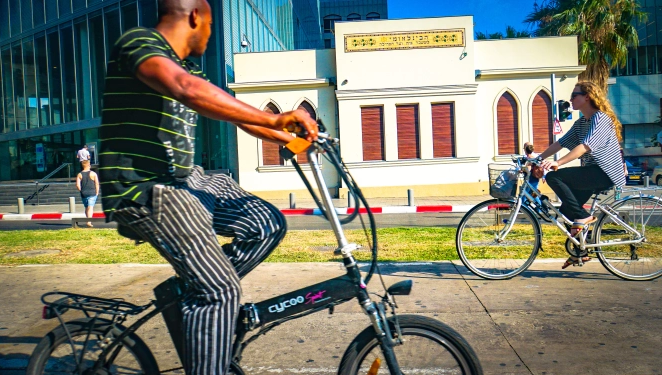American communities can expand access to e-bike incentive programs by using data to better connect their benefits to community goals like mobility justice and ending climate change, a new analysis argues — and there's a great blueprint for how to do it right now.
In a new white paper from Portland State University, researchers looked at more than 70 current, former, and upcoming efforts to subsidize the use of electric bicycles in the U.S. and Canada, and how those local programs might have an even bigger impact in the future — and eventually, win more funding at the local, state, and federal level.
Virtually unheard of just a decade ago, e-bike incentives like rebates, vouchers, tax credits, and even simple lending libraries have proliferated in recent years and have emerged as a goal among national legislators, who see the mode's potential to decrease emissions, make streets safer, and address health problems among riders all at once. That potential is particularly strong among people less likely to use an acoustic cycle, like seniors, people with mobility challenges, and people who just don't want to get sweaty on their way to their destination.
Early research has shown that 62 percent of North American e-bike trips replace a journey that would have otherwise been taken in a car, and access to e-bike share alone can reduce a city residents' automobile mileage by 20 percent. And like with all forms of cycling, people ride far more when they have excellent protected infrastructure to match their pedal-assist bikes.
The Portland State authors, though, say that e-bike incentives still aren't an easy sell among the groups that are best poised to create them, even in cities that have already done some of the necessary work of building bikeable streets.
"People tend to say, 'E-bikes are fine, but we don’t believe these actually reduce vehicle miles traveled. We don’t have a really good understanding of their impact on mode shift and car replacement,'" said John MacArthur, sustainable transportation manager for the Transportation Research and Education Center at PSU. "So we said, 'Well, let's put together the proof.'"
To get more policymakers on board, MacArthur says advocates need more data about how providing e-bike incentives can help accomplish community goals — and what types of incentives work best among the riders who need financial assistance most. Because right now, he says, some program at administrators are basically throwing spaghetti at the wall.
"In a lot of cases, the conversation [about how an e-bike incentive should work] is basically, 'OK, let’s take the total amount of money we have for incentives and divide it by X number of people we want to reach,'" he said. "So we'd end up with people saying, 'Two hundred dollars sounds good,' or 'Five hundred dollars sounds good.' It's really arbitrary."
To understand what an effective program might look like, MacArthur put together an ongoing e-bike incentive program tracker to see how the details of those North American programs stack up, followed by interviews with many of those programs' administrators.
And they found some surprising trends:
- Despite their ability to help achieve municipal goals, local governments are not the leading providers of e-bike incentives, administering just 24 percent of active programs. Power districts like utility companies, who use the programs to meet their greenhouse gas reduction requirements, are actually the largest e-cycling boosters (41 percent), with nonprofits, states governments, private companies, and air quality management authorities picking up the slack.
- Only 25 percent of programs are restricted to low- to mid-income residents, which might be a good thing or a bad thing depending on your perspective.
- Most programs (58 percent) provide recipients with just $200-600 in benefits, or just 7 to 23 percent of the average $2,600 a personal e-bike costs.
- Half of the programs only allow recipients to purchase from local dealers, which is great for municipal economies, but potentially not so great for buyers, who can get cheaper bikes through direct-to-consumer retailers online.
To build a better e-bike incentive — and eventually, make these subsidies a front-line climate, equity and safety strategy in more places — MacArthur says program administrators should be more deliberate about shaping their incentives around the goals they'd most like to accomplish, and think deliberately about what forms those incentives should take and how big they should be. (Answers to the second question may be coming soon: he and his colleagues are in the process of conducting a 20-city survey to see exactly how much money it would take to get Americans from various background in the saddle, with results expected later this year.)
Doing this, of course, would put a much closer microscope on e-bike incentives than have pretty much ever been placed on electric car incentives, which U.S. communities tend to treat as a universal good even when their climate, road violence and equity benefits prove dubious. The now-dead Build Back Better Act faced criticism among sustainable transportation advocates for proposing a $12,500 federal tax credit to e-car drivers whose households make up to $400,000 a year, while offering a max of just $1,500 for e-bikes, with even smaller benefits for single heads of households making just $75,000.
Still, MacArthur says that sweating the details on e-bike subsidy programs now could help them have a bigger impact on local goals down the road — which could, in turn, make the case for more skeptical communtiies to follow their example. And the time to start is now — because even in cities like his with relatively robust protected bike infrastructure, these programs could be a serious game changer.
"In Portland, we’re stagnating at 7 percent [bicycle mode share], but we need to get to 25 percent to meet our climate goals," he adds. "E-bikes are that additional catalyst."






